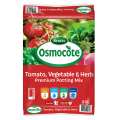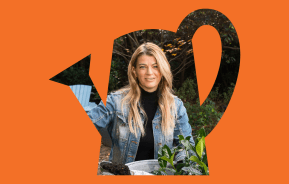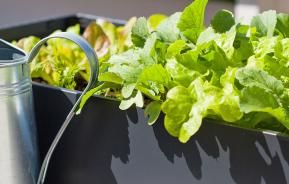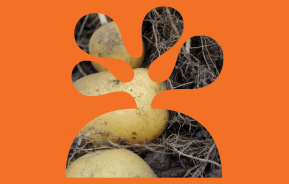Making a pallet garden bed is really quick and easy. You’ll use old wooden pallets, which provide a readymade wooden framework, so there’s little to construct, and the materials can usually be found for free. Just add soil and you're halfway to creating a raised garden. We’ve also got some great ideas for plants that will grow well in your new pallet bed. So let’s get started.
How To Make Raised Beds With A Pallet In 5 Steps
1. Prepare
You will need the following equipment:
- Gloves
- Garden fork
- Rake
- Pallet
- Trowel
- Mallet
- Potting mix
- Plants or seeds
- Pen
Find a part of the garden which is big enough to accommodate the pallet when it is laid flat. The spot should receive a good amount of sunshine, with gentle shade for part of the day. Get the area ready by using the garden fork to clear the ground of weeds, and remove any other debris.
2. Get the location ready
Even out the ground with the rake. Add a layer of Scotts Osmocote® Compost Premium Soil Improver to give the soil a boost, and rake even. Lift the pallet into place, upper-most side face down so that the gaps are face up. Gently press the pallet into the soil. Lift the pallet away again and use the trowel to dig 2” deep along the outside indentations in the soil. This will help to stabilise the pallet. Put it back on top of the soil, into the indentations, and use the mallet to gently firm into place.
4. Fill the pallet garden
Add enough potting mix to the open spaces of the pallet so that they are nearly full to the top. Gently firm the mix as you fill it, so that plants have a good base in which to set their roots. You can sow seeds in the potting mix or plant small herbs, vegetables and annual flowers. Write the names of the seeds and plants on the wooden slats of the pallet so that you know what is planted in each section.
5. Look after the pallet garden
Water the seeds and plants to help them get established, and during any hot spells when the pallet might dry out. Use a fertiliser to keep plants healthy and productive. We like Scotts Osmocote® Plus Organics Tomato Vegetable & Herb Plant Food & Soil Improver. Remove any weeds that pop up in the soil, as well as any yellowing parts of plants. Harvest crops as soon as they are ready.
What Plants Grow Well In A Pallet Garden Bed
Many varieties of herbs, vegetables and annual flowers can be grown in a pallet garden. Generally don’t choose plants which are grown for their roots, such as carrots and potatoes, as the depth of the pallet bed is limited. There are exceptions, for example you could try a chantenay variety of carrot which is short and stout, or smaller varieties of radish such as ‘French Breakfast’. There are many other plants which are suited to a pallet garden – consider the following plants for your pallet garden ideas:
- Herbs, such as chives, basil and coriander: Chives can be grown as a perennial, and the strong onion scent will help to deter many pests and diseases. Basil and coriander are expensive to buy fresh, but easy to grow yourself in a pallet herb garden.
- Annuals, such as colourful marigolds, nasturtiums, pansies and snapdragons: Pansies are super as they flower from late autumn through to spring, when there isn't much else offering colour in the garden.
- Lettuce: As these are shallow rooted, they are perfect for a pallet garden and can provide a crop of leaves all year round. Explore different varieties for a mix of leaf colours and shapes. Cut-and-come-again varieties allow you to remove leaves and will regrow. Other types, such as ‘Little Gem’ and ‘Lolla Rossa’, produce a heart which is cut once it has filled out. Harvest lettuce 6-8 weeks after sowing.
- Spring onions: Sow direct into the bed from September onwards, and harvest after 2-3 months. Thin them out as you pick them, allowing the ones which are left to expand into the newly created spaces.
- Dwarf French beans: Quick to germinate, sow them indoors and plant them out into the pallet garden bed once the soil is warmer, so from September onwards. Harvest 2-3 months after sowing. Beans can be cut fresh or left to dry in their pods and stored for using in soups and casseroles. Dwarf beans do not need support.
- Capsicum and chilli peppers: Sow these indoors and plant out once 4-5” tall. They love warmth and will take about 6 months to produce edible peppers, but are worth the wait as they look and taste delicious!
- Eggplant (aubergine): As with chilli and capsicum, these have a slow start but are worth it for the beautiful purple fruits. Choose a variety which will produce smaller aubergines, as larger fruits grown outdoors take longer to mature.
- Tomatoes: Upright or bush varieties will both work well in a pallet garden. Upright varieties need support with a cane and string. Homegrown tomatoes cannot be beaten for flavour and there are many different colours and shapes to choose from.
- Cucumbers: Can be grown upright with support to save space or allowed to sprawl across the pallet and garden. Cucumbers are shallow rooted, so they are perfect for a pallet garden.








